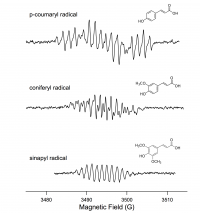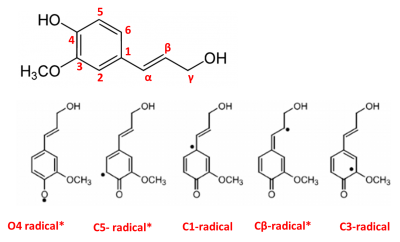Difference between revisions of "Oxidation of Lignin Monomers"
(Created page with "<!-- ==Curcumin Research Initiative== --> You have reached the page dedicated to the research of lignin monomers. This page was created by Stephanie Saey and...") |
|||
| Line 1: | Line 1: | ||
<!-- ==Curcumin Research Initiative== --> | <!-- ==Curcumin Research Initiative== --> | ||
You have reached the page dedicated to the research of lignin monomers. This page was created by [[Stehanie_Saey|Stephanie Saey]] and will be maintained by Zelinda Taylor. Stephanie was a 2018 Biochemistry/Biopsychology graduate and Zelinda is currently a Junior Biochemistry research student. | You have reached the page dedicated to the research of lignin monomers. This page was created by [[Stehanie_Saey|Stephanie Saey]] and will be maintained by Zelinda Taylor. Stephanie was a 2018 Biochemistry/Biopsychology graduate and Zelinda is currently a Junior Biochemistry research student. | ||
| + | |||
| + | ==[https://en.wikipedia.org/wiki/Lignin Lignin] monomers== | ||
| + | [[File:Ligin Monomer radicals.png|200px|thumb|center|ESR data from HRP oxidation of lignin monomers]] | ||
| + | :[https://en.wikipedia.org/wiki/Paracoumaryl_alcohol p-coumaryl alcohol] | ||
| + | :[https://en.wikipedia.org/wiki/Coniferyl_alcohol coniferyl alcohol] | ||
| + | :[https://en.wikipedia.org/wiki/Sinapyl_alcohol sinapyl alcohol] | ||
===Abstract === | ===Abstract === | ||
The biosynthesis of the lignin polymer occurs through oxidative coupling between three basic monomers: p-coumaryl alcohol, coniferyl alcohol, and sinapyl alcohol. The chemical structure of each lignin monomer includes a characteristic phenol group that contributes stability to the assumed radical intermediate formed upon oxidation. In this work, immobilized horseradish peroxidase was used to oxidize the coniferyl alcohol and to directly detect the radical intermediate using immobilized enzyme - ESR spectroscopy (IE-ESR). Oxidation products were analyzed by HPLC and findings will be discussed in terms of both lignin and lignan synthesis. | The biosynthesis of the lignin polymer occurs through oxidative coupling between three basic monomers: p-coumaryl alcohol, coniferyl alcohol, and sinapyl alcohol. The chemical structure of each lignin monomer includes a characteristic phenol group that contributes stability to the assumed radical intermediate formed upon oxidation. In this work, immobilized horseradish peroxidase was used to oxidize the coniferyl alcohol and to directly detect the radical intermediate using immobilized enzyme - ESR spectroscopy (IE-ESR). Oxidation products were analyzed by HPLC and findings will be discussed in terms of both lignin and lignan synthesis. | ||
| + | |||
| + | ===Preliminary ESR data=== | ||
| + | Lignin monomer radicals were detected using 50/50 water/dioxane (pH 5) to solublize polymer products; immobilized HRP. Quantum calculations to analyze each spectra are in progress; however, for now it can most definitely be concluded that each monomer has the ability to form radicals under oxidative conditions. | ||
| + | |||
| + | ===Oxidation of Coniferyl Alcohol=== | ||
| + | The chemical structure of coniferyl alcohol allows for various places where coupling may occur once the radical forms (Image A and Image B). Coniferyl alcohol was oxidized under various reaction conditions to gain insight into the number of products formed by these radical-radical coupling reactions. The first reaction was carried out with 2mM coniferyl alcohol in the presence of HRP catalyst. The second reaction was carried out with 2mM coniferyl alcohol in the presence of both HRP and 0.5 mM hydrogen peroxide. Subsequently, a third reaction was carried out involving 2mM coniferyl alcohol, catalase, and HRP. In the latter reaction, catalase was added last to the reaction beaker. | ||
| + | |||
| + | [[File:coniferylpredictions.png|400px|thumb|none|Image A: Con]] | ||
| + | |||
| + | ===References=== | ||
| + | Heitner, C., Dimmel, D.R., and Schmidt, J. (2010). Lignin and lignans: advances in chemistry. | ||
| + | Li X, Yang Z, Zhao M. (2012). Neuroprotective effects of Flax Lignan against NMDA‐induced neurotoxicity in vitro. CNS Neuroscience & Therapeutics, 18(11).927-933. | ||
| + | Vanholm, R., Demedts, B., Morreel, K., Ralph, J., and Boerjan, W. Lignin biosynthesis and structure. (2010). Plant Physiology. doi:10.1104/pp.110.155119 | ||
Revision as of 00:55, 11 May 2018
You have reached the page dedicated to the research of lignin monomers. This page was created by Stephanie Saey and will be maintained by Zelinda Taylor. Stephanie was a 2018 Biochemistry/Biopsychology graduate and Zelinda is currently a Junior Biochemistry research student.
Lignin monomers
Abstract
The biosynthesis of the lignin polymer occurs through oxidative coupling between three basic monomers: p-coumaryl alcohol, coniferyl alcohol, and sinapyl alcohol. The chemical structure of each lignin monomer includes a characteristic phenol group that contributes stability to the assumed radical intermediate formed upon oxidation. In this work, immobilized horseradish peroxidase was used to oxidize the coniferyl alcohol and to directly detect the radical intermediate using immobilized enzyme - ESR spectroscopy (IE-ESR). Oxidation products were analyzed by HPLC and findings will be discussed in terms of both lignin and lignan synthesis.
Preliminary ESR data
Lignin monomer radicals were detected using 50/50 water/dioxane (pH 5) to solublize polymer products; immobilized HRP. Quantum calculations to analyze each spectra are in progress; however, for now it can most definitely be concluded that each monomer has the ability to form radicals under oxidative conditions.
Oxidation of Coniferyl Alcohol
The chemical structure of coniferyl alcohol allows for various places where coupling may occur once the radical forms (Image A and Image B). Coniferyl alcohol was oxidized under various reaction conditions to gain insight into the number of products formed by these radical-radical coupling reactions. The first reaction was carried out with 2mM coniferyl alcohol in the presence of HRP catalyst. The second reaction was carried out with 2mM coniferyl alcohol in the presence of both HRP and 0.5 mM hydrogen peroxide. Subsequently, a third reaction was carried out involving 2mM coniferyl alcohol, catalase, and HRP. In the latter reaction, catalase was added last to the reaction beaker.
References
Heitner, C., Dimmel, D.R., and Schmidt, J. (2010). Lignin and lignans: advances in chemistry. Li X, Yang Z, Zhao M. (2012). Neuroprotective effects of Flax Lignan against NMDA‐induced neurotoxicity in vitro. CNS Neuroscience & Therapeutics, 18(11).927-933. Vanholm, R., Demedts, B., Morreel, K., Ralph, J., and Boerjan, W. Lignin biosynthesis and structure. (2010). Plant Physiology. doi:10.1104/pp.110.155119

